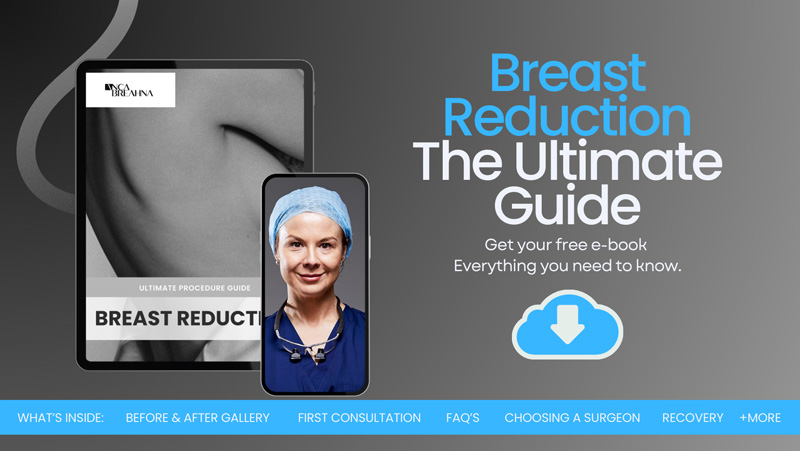
Macromastia Causes and Treatment Options
Macromastia, also known as breast hypertrophy, is a rare condition characterised by the excessive growth of breast tissue, leading to overly large breasts. This condition affects women of all ages and can have physical, emotional, and psychological implications. In this blog, Chester Consultant Plastic Surgeon Anca Breahna will explore the causes of macromastia and gigantomastia and the various treatment options available to address this condition.
Download Anca’s Breast Reduction Guide

Symptoms Often Associated with Having Large Breasts
Among the most common physical discomforts are chronic back, neck, and shoulder pain, resulting from the strain of supporting excess weight. This discomfort can be exacerbated by physical activities, leading many women to limit their exercise and, consequently, their overall physical health. Pros and Cons of D Cup Breasts often highlight the unique challenges faced by women with larger breast sizes, as well as the potential for discomfort that can affect posture and daily activities.
Skin issues are another frequent concern, with rashes and skin irritation developing under the breast crease due to trapped moisture and friction. Additionally, deep indentations and pain from bra straps digging into the shoulders are common, as finding supportive and well-fitting undergarments can be a challenge.
Beyond the physical symptoms, large breasts can also contribute to psychological distress. Many women experience self-consciousness, reduced self-esteem, and body image issues, particularly if they feel their body is out of proportion. The unwanted attention and comments about one’s appearance can lead to social anxiety and withdrawal.
These symptoms, both physical and emotional, underscore the importance of addressing the needs of women with large breasts, whether through medical intervention, supportive therapies, or finding community and understanding among others with similar experiences.
Causes of Macromastia
The causes of macromastia are multifaceted, involving genetic factors, hormonal influences, and environmental factors, including obesity:
- Genetic Factors: Genetics play an important role in determining breast size and the susceptibility to macromastia. Research indicates that macromastia can run in families, suggesting a hereditary component. Specific genes associated with breast size and tissue growth can be more prevalent in certain families, leading to a higher likelihood of developing the condition. This genetic predisposition means that women with a family history of macromastia are at a greater risk, underscoring the importance of genetics in understanding and managing the condition.
- Hormonal Influences: Hormones significantly affect breast tissue growth and can thus influence the development of macromastia. Oestrogen and progesterone, in particular, play critical roles in breast development during puberty, pregnancy, and menopause. An imbalance in these hormones can lead to excessive breast tissue growth. Conditions like hyperestrogenism, where there is an overproduction of oestrogen, can contribute to the development of macromastia. Additionally, some medical conditions and treatments that affect hormonal balance can also lead to an increase in breast size, highlighting the complex relationship between hormones and breast tissue growth.
- Obesity and Environmental Factors: Obesity is a significant risk factor for macromastia. Excess fat accumulation can contribute to increased breast size, and obesity can also lead to hormonal imbalances that further exacerbate breast tissue growth. Moreover, environmental factors, including diet and lifestyle, play a role in both obesity and hormone regulation. Exposure to certain chemicals and pollutants, known as endocrine disruptors, can interfere with hormonal functions and potentially contribute to the development of macromastia. These environmental influences, coupled with genetic predispositions and hormonal factors, create a complex web of causes that can lead to the condition.
Different Types of Macromastia
Gigantomastia is an extreme form of macromastia, defined by the rapid and excessive enlargement of breast tissue, often leading to physical discomfort and various health issues. Unlike macromastia, gigantomastia involves an even more significant increase in breast size, which can pose severe challenges to those affected. The condition is generally classified based on its timing in relation to certain life stages or its underlying causes, providing insights into its complex nature:
- Puberty-Induced Gigantomastia: This type occurs during adolescence as the breasts begin to develop. It’s thought to be a result of an abnormal response to the body’s hormonal changes during puberty. Girls experiencing puberty-induced gigantomastia may see their breasts grow rapidly and disproportionately large compared to their peers, which can lead to physical discomfort and emotional distress during a formative period of their lives.
- Pregnancy-Associated Gigantomastia: Some women may develop gigantomastia during pregnancy, a time when the body undergoes significant hormonal fluctuations. This type can be particularly challenging, as it not only adds to the physical burden during pregnancy but can also complicate breastfeeding and postpartum recovery.
- Drug-Induced Gigantomastia: Certain medications can trigger breast tissue expansion, leading to gigantomastia. Hormonal treatments, including some contraceptives and hormone replacement therapies, are typical culprits. Identifying the medication causing the issue is crucial for treatment, as discontinuing the drug can sometimes reverse the condition.
- Idiopathic Gigantomastia: In some cases, the cause of gigantomastia remains unknown, classifying it as idiopathic. This type poses a particular challenge for treatment, as the underlying trigger is not clear, making management focused on alleviating symptoms rather than addressing the root cause.
Non-Surgical Management Strategies
Non-surgical management strategies for macromastia focus on alleviating symptoms and improving the quality of life for women affected by this condition. These approaches are particularly relevant for those who may not be candidates for surgery, prefer to avoid surgical interventions, or wish to explore other options first.
- Weight Management and Lifestyle Changes: Given the link between obesity and macromastia, achieving a healthy weight through a balanced diet and regular exercise can significantly reduce breast size and alleviate symptoms. Weight loss can decrease fatty tissue in the breasts, leading to a reduction in breast volume and the associated physical discomforts, such as back pain and skin irritation. Moreover, adopting a healthier lifestyle can improve overall body composition and hormonal balance, further contributing to symptom relief. Nutritional counselling and personalised fitness plans can be valuable resources for women looking to make these changes.
- Physical Therapy and Support Garments: Physical therapy can offer exercises specifically designed to strengthen the back, shoulders, and chest muscles, supporting the breasts more effectively and reducing pain and discomfort. In addition, wearing well-fitted support garments, such as bras with wide straps and proper back support, can distribute breast weight more evenly and prevent strain on the shoulders and back. Specialty stores and medical professionals can provide fittings and recommendations for such garments, ensuring they meet the individual’s needs.
- Medication and Hormonal Therapy: In some cases, medication can help manage symptoms of macromastia. For example, anti-inflammatory drugs may relieve pain and discomfort associated with the condition. Hormonal therapy, aimed at addressing hormonal imbalances, can also be an option, particularly for women whose macromastia is linked to oestrogen dominance. However, this approach requires careful consideration and monitoring by healthcare providers, as hormonal treatments can have side effects and may not be suitable for everyone.
Surgical Treatment Options for Macromastia
Surgical treatment options for macromastia offer a more definitive solution for women seeking relief from the physical and emotional burdens of excessively large breasts. Breast reduction surgery and liposuction are the most commonly pursued interventions. Each method has its specific indications, techniques, and recovery expectations, tailored to meet the unique needs and your goals.
- Breast Reduction Surgery: Breast reduction surgery, medically referred to as reduction mammoplasty, is designed to remove excess breast tissue, fat, and skin to achieve a breast size in proportion with your body and to alleviate the discomfort associated with overly large breasts. The surgical techniques vary, including the traditional anchor-shaped incision, the vertical incision, and the scar-less liposuction method, each chosen based on the your specific anatomical requirements and aesthetic goals. The primary objectives of breast reduction surgery are to reduce physical discomfort, improve the ability to engage in physical activities, and enhance self-image and quality of life. This procedure not only addresses the physical implications of macromastia but also aims to restore balance and harmony to your proportions.
- Liposuction: Liposuction can be an effective surgical option for breast reduction in cases where excess fatty tissue is the main contributor to breast size, and there is minimal need for skin removal. This technique is less invasive than traditional breast reduction surgery and can result in smaller scars. It is particularly suited for patients who require a modest reduction in breast size and those who wish to avoid the more extensive scarring associated with traditional reduction techniques. However, it’s important to have realistic expectations, as liposuction might not achieve the same degree of lift and shaping as a full breast reduction.
- Recovery and What to Expect: Recovery from breast reduction surgery varies among women, but you can generally expect a period of rest followed by gradual return to normal activities. Pain, swelling, and bruising are common post-operative experiences, managed with medications prescribed by Anca. You can resume work and light activities within a few weeks, with full recovery and the final shape of the breasts emerging after several months. It’s crucial for you to follow Anca’s guidance on post-operative care, including wearing supportive garments and attending follow-up appointments, to ensure optimal healing and outcomes.
Does Breast Reduction Surgery Result in Scarring?
Breast reduction procedures, while offering significant relief and aesthetic improvements for women suffering from macromastia, do indeed result in scarring. The extent and visibility of these scars are influenced by the surgical technique used, your skin type, and your individual healing process. Common surgical approaches, such as the traditional anchor or inverted T incision, the vertical or “lollipop” incision, and the periareolar incision around the nipple, each leave distinct patterns of scars. These are strategically placed to be as inconspicuous as possible, typically under the breast fold or around the areola, making them less noticeable under clothing or swimwear.
The healing process plays a crucial role in the final appearance of scars. Over time, most scars will fade to fine lines, becoming less noticeable. Factors such as genetics, skin colour, and adherence to post-operative care instructions significantly affect scar maturation. Anca often recommends treatments like silicone sheets, scar massage, and laser therapy to enhance scar healing and appearance.
FAQs about Causes and Treatment of Overly Large Breasts – Macromastia
Can macromastia develop at any age, or is it limited to certain stages of life?
- Macromastia can occur at any age but is more commonly observed during periods of significant hormonal changes, such as puberty, pregnancy, and menopause. However, factors like weight fluctuations and genetic predisposition can also contribute to its development outside these stages.
Is it possible for macromastia to resolve on its own without treatment?
- In some cases, particularly when macromastia is related to hormonal changes during puberty or pregnancy, the condition may improve over time without intervention. But persistent macromastia typically requires treatment to alleviate symptoms and prevent further complications.
Are there specific exercises that can help reduce breast size in cases of macromastia?
- While exercise can help in weight management and potentially reduce the fatty component of breast tissue, it cannot directly reduce breast size significantly in cases of true macromastia. A comprehensive approach including medical consultation is often necessary for effective management.
Can dietary changes impact the severity of macromastia?
- A balanced diet can aid in overall weight management, which may have a secondary effect on breast size, especially if obesity is a contributing factor. But dietary changes alone are unlikely to significantly reduce breast size in cases of macromastia.
What are the potential risks or complications of breast reduction surgery?
- As with any surgery, breast reduction comes with potential risks, including bleeding, infection, changes in nipple or breast sensation, and scarring. The specific risks can vary based on individual health and the surgical technique used.
Further Reading about Breast Reduction with Consultant Plastic Surgeon Anca Breahna
- Read more about 8 Myths about Breast Reduction Surgery
- Read more about 10 Things to Consider Before a Breast Reduction
- Read more about Private Breast Reduction Surgery in UK
- Read more about All about Perfect Breasts and How to Get Them
- Read more about Back, Shoulder and Neck Pain Caused by Large Breasts
Medical References about Breast Reduction Surgery
- Breast Reduction Surgery – WebMD
- Breast Reduction Surgery | Johns Hopkins Medicine
- Breast Reduction (female) – NHS
- Breast Reduction | American Society of Plastic Surgeons
- Breast reduction surgery – Mayo Clinic


 Ms Anca Breahna, PhD, MSc, FEBOPRAS, FRCS (Plast) is a highly regarded Consultant Plastic Surgeon specialising in the field of Aesthetic and Reconstructive Plastic Surgery. Anca performs a range of
Ms Anca Breahna, PhD, MSc, FEBOPRAS, FRCS (Plast) is a highly regarded Consultant Plastic Surgeon specialising in the field of Aesthetic and Reconstructive Plastic Surgery. Anca performs a range of 